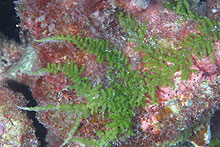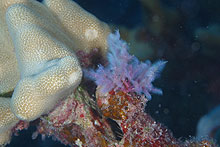NOWRAMP
2002
Limu
Written By Carlos Eyles
Underwater Photography by Jim
Watt
October 3, 2002
 Last
night we had an all hands meeting. Randy Kosaki, the chief
scientist spoke of our return, and how we would be pulling
in to Aloha Tower on Monday the 7th of this month, four
days away. In that moment, you could feel the helium leave
the village balloon. Nothing was said in that regard, perhaps
a collective sigh that only a monk seal could hear, but
I certainly felt it. The work schedule has been the most
intense that I have ever experienced. Those on board have
been phenomenal in terms of their capacity to endure sixteen
hour work days and nights week in and week out. But you
can't go on indefinitely at that pace, and today we are
in the middle of a thirty-seven hour transit, and things
have understandably slowed. People are still focused at
their computers, there is still work to be done, actually
quite a bit of work, but the frenetic energy that propelled
us these last twenty-five days is absent. Fortunately we
have a following sea to ease the rock and roll so the work
flows out of the computers with the regularity of a Swiss
watch.
Last
night we had an all hands meeting. Randy Kosaki, the chief
scientist spoke of our return, and how we would be pulling
in to Aloha Tower on Monday the 7th of this month, four
days away. In that moment, you could feel the helium leave
the village balloon. Nothing was said in that regard, perhaps
a collective sigh that only a monk seal could hear, but
I certainly felt it. The work schedule has been the most
intense that I have ever experienced. Those on board have
been phenomenal in terms of their capacity to endure sixteen
hour work days and nights week in and week out. But you
can't go on indefinitely at that pace, and today we are
in the middle of a thirty-seven hour transit, and things
have understandably slowed. People are still focused at
their computers, there is still work to be done, actually
quite a bit of work, but the frenetic energy that propelled
us these last twenty-five days is absent. Fortunately we
have a following sea to ease the rock and roll so the work
flows out of the computers with the regularity of a Swiss
watch.
 So
much of my focus throughout this expedition has been on
the dramatic; sharks, ulua, fish populations, shipwrecks,
and the like. But much of the science has focused on the
baseline foundations of a reef system. The coral and other
invertebrates, algal studies, terrestrial studies, all seemingly
uninteresting until one begins to spend time with these
specialists. Their enthusiasm for their respective fields
is infectious, and they know that without the seaweed, or
limu, (which means, the plant growing in a wet place), none
of the dramatic would exist, no sharks, no big fish, no
fish at all, not even the shipwrecks would occur. How you
might ask is that possible? Limu is the base, the very foundation
of the food chain. It captures the sun's energy and this
captured energy is transferred to other organisms. Limu
manufactures oxygen and releases it through photosynthesis.
Allow me to point out that before photosynthesis just a
mere 4 billion years ago there was no oxygen, no ozone layer,
no people, no animals, and no video games. That was a very
long time ago. Some microscopic limu even live within the
tissues of reef corals and they produce most of the food
these corals need to survive.
So
much of my focus throughout this expedition has been on
the dramatic; sharks, ulua, fish populations, shipwrecks,
and the like. But much of the science has focused on the
baseline foundations of a reef system. The coral and other
invertebrates, algal studies, terrestrial studies, all seemingly
uninteresting until one begins to spend time with these
specialists. Their enthusiasm for their respective fields
is infectious, and they know that without the seaweed, or
limu, (which means, the plant growing in a wet place), none
of the dramatic would exist, no sharks, no big fish, no
fish at all, not even the shipwrecks would occur. How you
might ask is that possible? Limu is the base, the very foundation
of the food chain. It captures the sun's energy and this
captured energy is transferred to other organisms. Limu
manufactures oxygen and releases it through photosynthesis.
Allow me to point out that before photosynthesis just a
mere 4 billion years ago there was no oxygen, no ozone layer,
no people, no animals, and no video games. That was a very
long time ago. Some microscopic limu even live within the
tissues of reef corals and they produce most of the food
these corals need to survive.
Most
limu is reproduced by spores that are carried by underwater
currents, the wind of the sea, they settle and begin to
grow, but must contend with surge, strong currents, sand
scouring, the grazing of herbivores, all which are factors
in their development and growth. Limu is instrumental in
creating three dimensional habitats in the tropics; they
are the cement of the reef, the consolidators. There are
many different kinds of limu, some five hundred species
in Hawai‘i. Some produce sand when they die, some are
as fine and delicate as a strand of hair, others are hard
and strong, often tougher and more resilient than the coral
in that it can handle far more abuse and thus build a reef
system in harsh, stormy conditions. They provide a reef
system with habitat, food, and oxygen; the big three.
 Here
in the Northwestern Hawaiian Islands there exists limu that
does not exist on the Main Islands. In this pristine environment
the limu is diverse and often plentiful, and the healthy
balance of a reef system is dependent on it. I asked Dr.
Karla McDermid the seaweed team leader, as well as an REA
team leader, what would happen if all the seaweed suddenly
vanished. She said first off there would be no food for
the manini, parrotfish, or green sea turtles. The herbivorous
(plant eating) fish would die, and leave the ulua and sharks
with nothing to eat. The reefs would lose their cement and
soon crumble and erode. The entire ocean ecosystem would
suffer a huge loss, the long-term consequences of which
would be ugly to say the least.
Here
in the Northwestern Hawaiian Islands there exists limu that
does not exist on the Main Islands. In this pristine environment
the limu is diverse and often plentiful, and the healthy
balance of a reef system is dependent on it. I asked Dr.
Karla McDermid the seaweed team leader, as well as an REA
team leader, what would happen if all the seaweed suddenly
vanished. She said first off there would be no food for
the manini, parrotfish, or green sea turtles. The herbivorous
(plant eating) fish would die, and leave the ulua and sharks
with nothing to eat. The reefs would lose their cement and
soon crumble and erode. The entire ocean ecosystem would
suffer a huge loss, the long-term consequences of which
would be ugly to say the least.
It's
all so delicate, a balancing act that is precarious at best.
The ocean is an enigma wrapped in a mystery. So strong and
powerful, yet so fragile and delicate. So intricate and
yet so simple. Its softness can embrace and its hardness
can kill. It appears invincible, but it is easily wounded.
It is long lived, but parts of it have died. It gives generously
but its generosity has limits. It is the life blood of the
planet and in its purity and stability lays the hope for
the future.
<<Journals
Home
 Talk About It!
Talk About It!
Algae and plant classification
Asked by Diane from Kealakehe Elem on Jan 22, 2004.
I just learned that algae is in a different classification than plants (protoctista). Why are they not plants? So technically, is a herbivore an animal that eats plants and non-animals (like algae)?
Answered by Paulo from UH on Jan 26, 2004.
Classification of life into neat and distinct groups is a difficult undertaking, one that needs to be updated and rearranged we discover new ones and understand the old ones better. Algae have their own kingdom, separate from that of the plant kingdom. This was not always the case, as algae were for a long time grouped together with plants by scientists. The reason that they were thought to be in the same group was that they both have the ability to photosynthesize (both have the ability to photosynthesize, but now we also know that even some form of bacteria can do this as well!). But unlike plants, algae do not develop from an embryo. Plants also have a vascular system (vein-like structures that transports nutrients within the organism) and roots used to absorb nutrients from the land, both of which algae do not have- being immersed in water they can absorb nutrients and other elements from everywhere (they anchor to the bottom with a “holdfast.”) The actual kingdom Protoctista is very varied, as the common trait among its members is the lack of traits the determine each of the other kingdoms- just as the majority of animals on earth are “invertebrates,” a group so varied that that the only common element is the lack of a vertebrate. There are a few plants (grass-like) that are found on the ocean, but for the most part, plants are terrestrial, whereas algae are strictly aquatic. So the term herbivore, which fits well on land animals (unless they also eat mushrooms too!), has to be interpreted broadly when applied to marine organism- the term “algaevore” never really stuck around, so we still use herbivore.